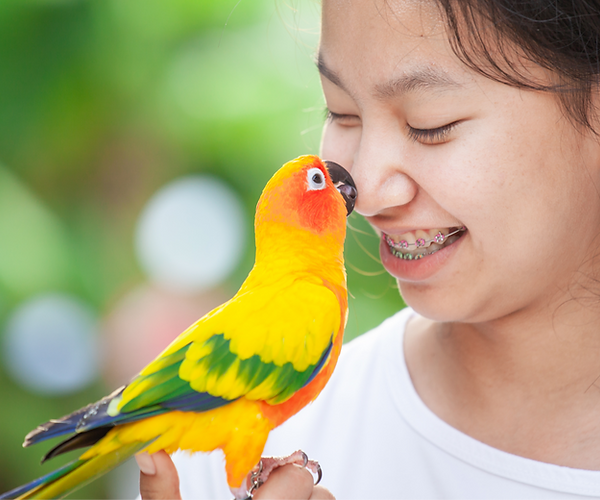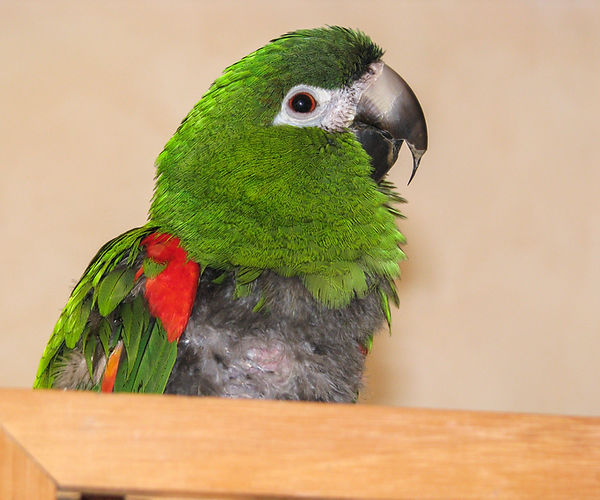
MiDOG technology can help diagnose your pet bird’s bacterial infection.
Your pet bird may be singing a different tune if they contract Avian Chlamydiosis. Avian Chlamydiosis is an infectious bacterial disease caused by Chlamydiophila psittaci, with the highest rates of infection being found in psittacine birds such as parrots, parakeets, macaws, and cockatiels [1]. Considering an estimated 16%-81% of parrots are infected with C. psittaci, it is important for any bird owner to be aware of signs of this difficult-to-diagnose disease [2].
Avian Chlamydiosis is painful for your feathery friend and if left untreated can result in serious health complications and even death. If you suspect your bird has Chlamydiosis, bring your pet to your veterinarian as soon as possible. Avian Chlamydiosis is a zoonotic disease, meaning that it is transmissible to humans, and so confirmation of this infection may require state-mandated reporting and testing [3].
What is Avian Chlamydiosis?
Several strains of the gram-negative, intracellular C. psittaci exist, with each strain imparting differential levels of severity on different types of bird species [2]. Both symptomatic birds and asymptomatic carriers of C. psittaci can transmit the disease-causing microorganism, with intermittent shedding of the bacteria occurring through nasal and fecal excretion [4]. Notably, the bacteria are resistant to adverse environments and can remain infectious for several months [5]. While the onset of clinical symptoms after exposure to C. psittaci ranges from three days to several weeks, latent infections are also common, with disease presentation not occurring until years after exposure in some cases [5]. Classification of Chlamydiosis can either be asymptomatic or symptomatic, with sub-classification of symptomatic presentations being acute, subacute, or chronic [2].
Clinical presentation of Chlamydiosis is influenced by bird species, the virulence of strain, infection load, stress, age, and treatment type [4]. While Chlamydiosis infections may be in latent stages or asymptomatic, it is important to know the clinical presentation of the disease when symptoms arise. Symptoms include but are not limited to:
- Lethargy
- Anorexia
- Ruffled feathers
- Serous or mucopurulent ocular or nasal discharge
- Diarrhea
- Excretion of green/yellow urates
- Dark green excrement
- Dehydration

Hahn’s macaw parrot with over grown beak and feather destructive behavior on chest. Visible symptoms of active psittacosis also known as parrot flu and chlamydia, due to infection in the liver.
How to Prevent Avian Chlamydiosis
The CDC recommends several measures in order to prevent the transmission of C. psittaci between birds:
- Do not purchase/sell birds that exhibit signs of Avian Chlamydiosis
- Quarantine any new bird 30-45 days, and test or prophylactically treat them before adding them to a group.
- Test birds for Avian Chlamydia before they are to be boarded or sold on consignment, and house them in a room separate from other birds.
- Practice preventative husbandry (proper cage positioning, daily cage cleaning, proper ventilation, etc.)
- Prevent infection (isolate suspected infected bird, disinfect the cage, reduce contamination, etc.)
- Regularly disinfect cage
Considering the possible asymptomatic nature of this disease, regular veterinary visits are recommended as well [4].
Treatment of Avian Chlamydiosis
Your veterinarian will test your feathery friend to determine the strain of bacteria causing your pet’s infection. Doxycycline medication is most commonly used for treating Chlamydiosis infections, and your veterinarian will determine the duration of treatment along with possible dietary supplements to aid in your bird’s recovery [5]. Additionally, your veterinarian can help you identify possible lifestyle changes you and your bird can make to improve their quality of life and lessen the risk of recurrent infections. This entails understanding the exact pathogen that is impacting your bird, with modern technological advances allowing for more targeted clinical diagnostic interventions.
Diagnosis of Avian Chlamydiosis
Diagnosis of Avian Chlamydiosis is particularly complex, largely due to the absence of clinical presentation in many cases. Antibody tests are limited in diagnostic settings, as positive serologic tests do not necessarily indicate an active infection. Conversely, birds with acute Avian Chlamydiosis may not have produced strong enough antibody responses yet to register a positive result, ultimately leaving antibody tests to be an insufficient indicator of C. psittaci infection [4]. Moreover, antigen tests also commonly produce false-negatives for C. psittaci, and so contemporary veterinary diagnostics has increasingly used Next-Gen Sequencing (NGS) as the gold standard for Avian Chlamydiosis clinical diagnostics [5]. NGS sequencing is especially useful in subclinical presentation of Chlamydiosis.
Next-Gen Sequencing (NGS) has increasingly helped researchers and veterinarians characterize avian microbiota [6]. A recent study aimed to detect the presence and characterize C. psittaci using NGS techniques in captive birds of Costa Rica and went on to reaffirm the importance of NGS approaches in avian diagnostics [2]. This research indicates the clinical applicability of using genomic sequencing to identify, analyze, and eventually treat birds more effectively [2].
Despite its name, the MiDOG All-in-One Microbial Test may provide the answer to the diagnostic conundrum that Avian Chlamydiosis poses on your feathery friend. Utilizing NGS technology to detect and quantify all microbial DNA through untargeted and comprehensive sequencing and quantitative comparisons to reference databases, the MiDOG NGS technology provides a useful opportunity to shed light on the microbial makeup of your bird’s infection for clinical application [7]. The MiDOG microbiome test is a microbial identification test grounded on scientific research that provides veterinarians DNA evidence for the guided treatment of bird infections, such as Chlamydiosis.

MiDOG technology can help diagnose your bird’s bacterial and fungal infections.
Find out if your vet uses MiDOG before you book your next appointment!
References:
[1] Balsamo, G., Maxted, A. M., Midla, J. W., Murphy, J. M., Wohrle, R., Edling, T. M., . . . Tully, T. N. (2017). Compendium of measures to CONTROLCHLAMYDIA Psittaciinfection among humans (PSITTACOSIS) and pet Birds (Avian Chlamydiosis). Journal of Avian Medicine and Surgery, 31(3), 262-282. doi:10.1647/217-265
[2] Sheleby-Elías, J., Solórzano-Morales, Á, Romero-Zuñiga, J. J., & Dolz, G. (2013). Molecular detection and Genotyping of Chlamydia PSITTACIIN Captive Psittacines from Costa Rica. Veterinary Medicine International, 2013, 1-6. doi:10.1155/2013/142962
[3] Beeckman, D., & Vanrompay, D. (2009). Zoonotic Chlamydophila Psittaci infections from a clinical perspective. Clinical Microbiology and Infection, 15(1), 11-17. doi:10.1111/j.1469-0691.2008.02669.x
[4] Centers for Disease Control and Prevention. Compendium of measures to control Chlamydia psittaci infection among humans (psittacosis) and pet birds (avian chlamydiosis), 1998. MMWR 1998;47(No. RR-10):[inclusive page numbers].
[5] Hoppes, S. M. (n.d.). Bacterial diseases of pet birds – exotic and laboratory animals. Retrieved March 08, 2021, from https://www.merckvetmanual.com/exotic-and-laboratory-animals/pet-birds/bacterial-diseases-of-pet-birds
[6] Beckmann, K. M., Borel, N., Pocknell, A. M., Dagleish, M. P., Sachse, K., John, S. K., . . . Lawson, B. (2014). Chlamydiosis in British GARDEN BIRDS (2005–2011): Retrospective diagnosis and chlamydia PSITTACI Genotype determination. EcoHealth,11(4), 544-563. doi:10.1007/s10393-014-0951-x
[7] Melgarejo, T., et al., 2021. Canine Urine Microbiome: Assessment of Bacterial and Fungal Populations in Clinically Healthy Dogs Using Next-Generation-Sequencing. Journal of Veterinary Internal Medicine. IN PRESS
Categories: Birds/Parrots, Exotic Pets, Next-Gen DNA Sequencing Technology, Skin Health

